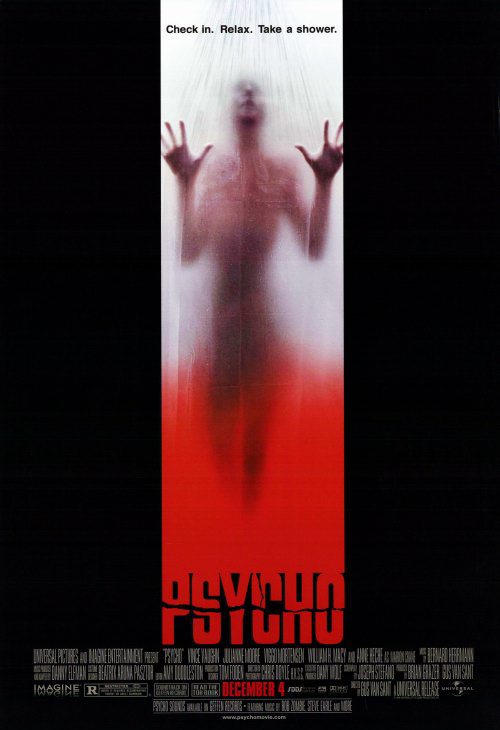

“We all go a little mad sometimes.”
Remakes and soft reboots happen all the time. Always have and presumably always will, as long as some of them occasionally make the studios that fund them significant amounts of money. Unfortunately, most are artistically underwhelming, with an exceedingly scant few proving to be minorly revelatory for one reason or another—bringing a unique slant to a well worn formula, fixing obvious flaws in an overlooked picture, that sort of thing. Think Invasion of the Body Snatchers or The Thing or The Fly.
Gus Van Sant’s Psycho, a remake of Alfred Hitchcock’s proto-slasher flick, is unlike any other remake that came before it. Seemingly driven by hubris rather than profit, Van Sant took an interesting approach. Instead of updating the material, shifting emphases, trying a different tone, or adding a few wrinkles to the plot, Van Sant took the word “remake” almost literally by staging a “shot-by-shot” recreation of the original. Well, “shot-by-shot” is a popular misconception, even if it’s not far from the truth. Despite working from the same script, using the same score (rearranged by Danny Elfman), and blocking most of his scenes more or less identically, Van Sant deviates from the original in a number of ways. He modernizes a few snatches of buttoned-up dialogue, replaces a lurid joke that was censored from the 1960 film (“Bed? Only playground that beats Las Vegas.”), adds in masturbation sound effects where slack-jawed peeping only implied it previously, updates the setting to current day with the inclusion of new technologies, splices in a few instances of hallucinatory imagery—all in all, a bunch of extraneous marginalia that don’t fundamentally alter the film very much. Aside from the fact that Van Sant’s film is in full color, you could easily be fooled into thinking it is basically faithful to the original. And, mechanically speaking, it is, which is the root cause of its failure.

The basic problem that arises is that Van Sant gets stuck in no man’s land, dragging Hitchcock’s material out of its time and place but electing not to advance his own artistic vision. By adopting the shot-by-shot mentality, the director is forced to constrain his cast, placing them in the same positions, walking them through the same motions, assigning the same lines of dialogue (more or less). Now, there is some variation in performance. Vince Vaughn, who plays Norman Bates, is more clearly unhinged from the start than Anthony Perkins was in the original (indeed, if one were to approach the film blindly—which is basically impossible, right?—there is little doubt that they’d see through Vaughn’s hotel proprietor in an instant, which isn’t the case with Perkins). Anne Heche’s Marion and Julianne Moore’s Lila subtly diverge from the earlier portrayals and Viggo Mortensen’s Sam is more credible than his predecessor. Only William H. Macy’s Arbogast seems to openly mirror the original performance. Ironically, Macy’s classical portrayal is the best one in Van Sant’s film. The others all seem too self-conscious and uncomfortable trying to differentiate themselves, their efforts further hampered by instances of unaltered dialogue that feel eccentric in their quaintness considering the update of the setting (for instance, when Bates shows Marion her room, he is reluctant to say the word “bathroom”). One has to wonder by what process Van Sant decided which elements should be transported to 1998 and which left in 1960.

These self-imposed constraints hamstring Van Sant to such an extreme degree that the whole picture plays as stilted and hollow. In denying himself the ability to flex, to direct with flair, to follow his muse—whatever you want to call it—by committing to the experiment of faithful replication, he finds himself with a clunky, unnatural, rhythmless film that struggles to justify itself as it slips halfway down the uncanny valley. The entire production, on both sides of the camera, is sapped of any creative inspiration, and the contrived final product pales when set against the subject of its forgery. The result, then, is a film that’s readable only in relation to its urtext—a less-than curio that makes for a decent classroom exercise of compare and contrast and perhaps an object lesson in the pitfalls of passion projects.
Defenses have been made, of course, but few of them have been brave enough to posit that the film itself is actually worthy in the way that we normally think and talk about films. Instead, they take a stand on philosophical and theoretical grounds—it’s an Andy Warhol-esque pop art experiment, a subversive prank played on the studio, an overly passionate homage, a postmodern culture clash, etc. All of that’s fine, even interesting to talk about (check out Mark Carpenter’s in-depth analysis for Off Screen), but no amount of clever hair-splitting is going to make Van Sant’s film more than a failed experiment.